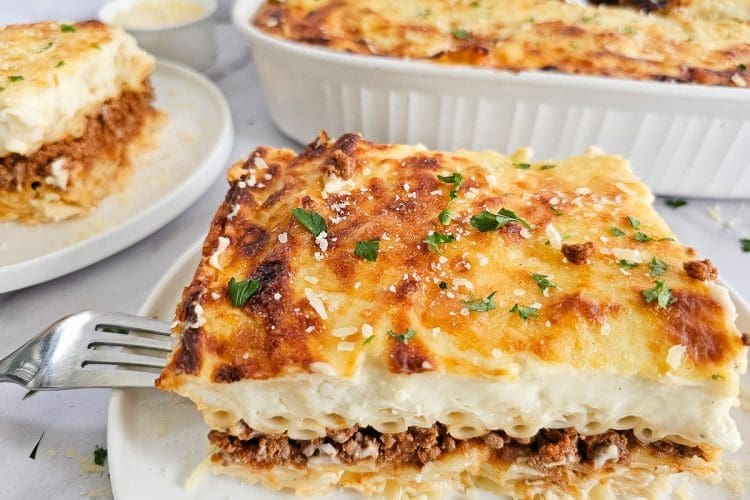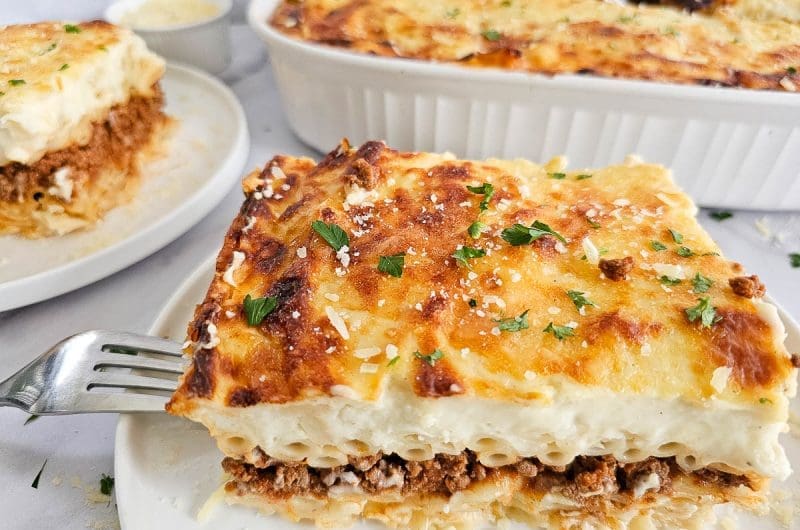You’ll love this traditional Pastitsio (Greek Pasta Bake) for its rich layers of pasta, flavourful seasoned meat sauce, and creamy cheese béchamel topping, a dish that’s sure to become a family favourite.
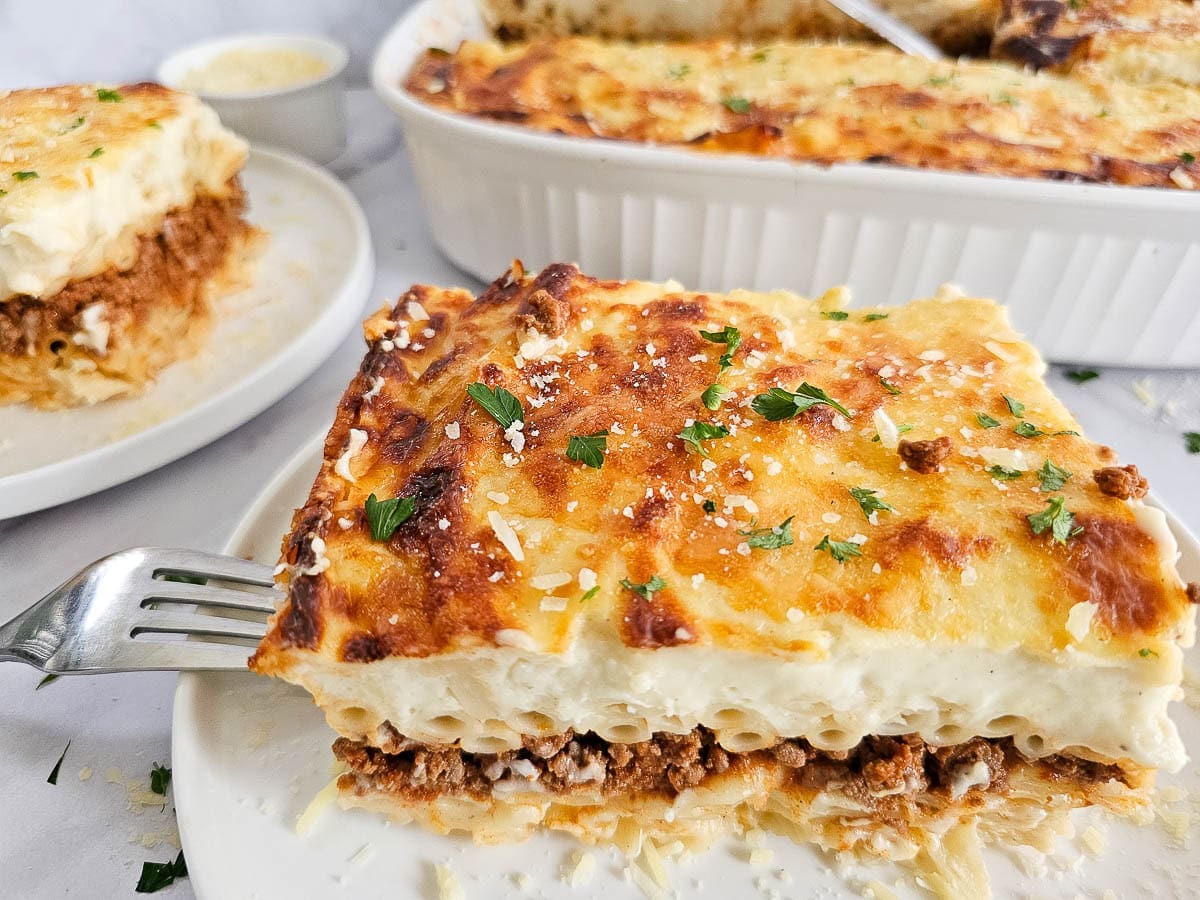
This would have to be one of my favourite dishes growing up. Whenever my mum mentioned Pastitsio for dinner, I knew I didn’t have to worry about hiding any leftovers under my napkin. In fact, it is the type of meal that leaves you wanting seconds, and the leftovers taste just as good.
Making Pastitsio is very similar to making lasagne, as it involves layering pasta, a rich minced meat Bolognese sauce and topped with a creamy Bechamel sauce.
What is in Pastitsio (Greek Pasta Bake)?
There are three different components to Pastitsio:
- The meat sauce
- The pasta
- The bechamel sauce
Ingredients for the meat sauce
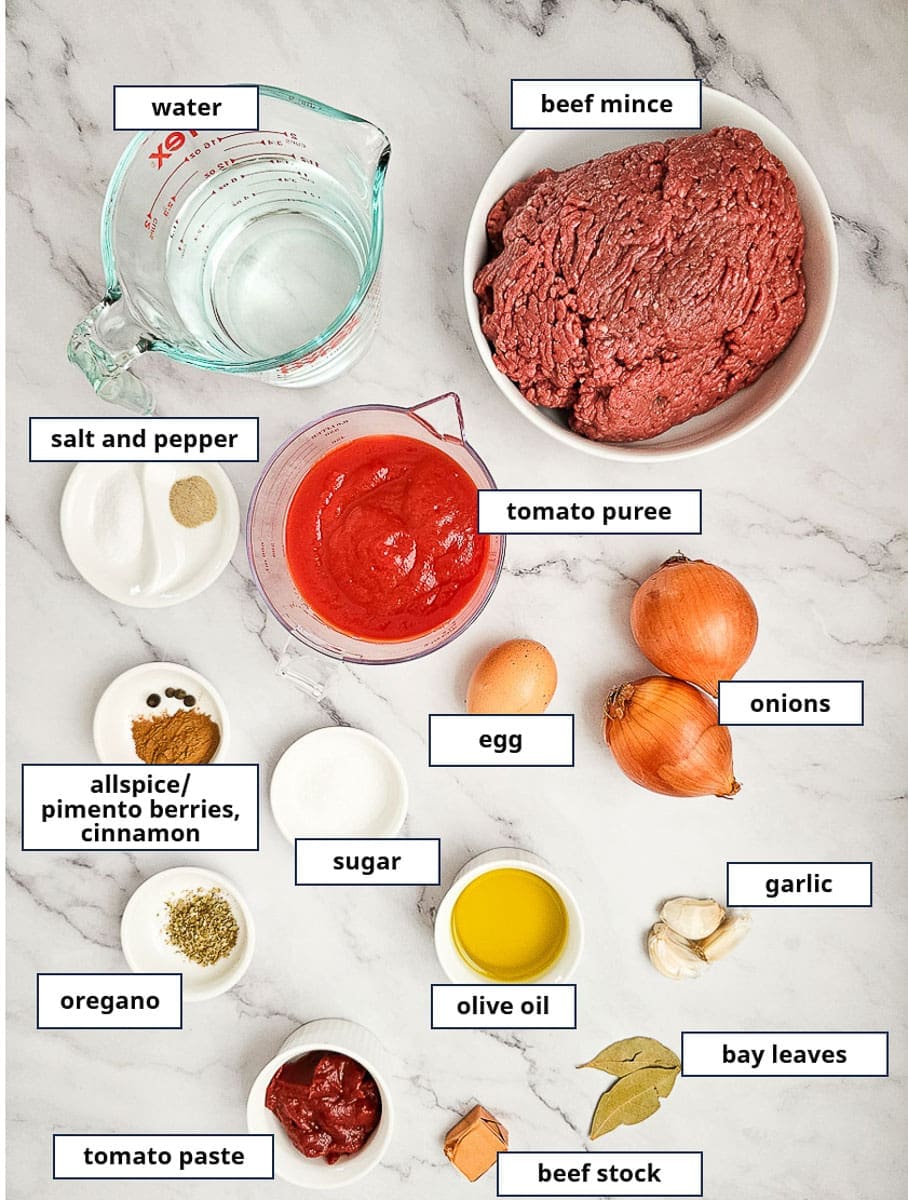
- Mince: I use lean beef mince because it contains less fat, resulting in a dish that is less oily and greasy.
- Allspice/Pimento berries: Allspice berries add a fragrant combination of cinnamon, cloves, and nutmeg, three commonly used spices in Greek cuisine. I find these berries in delicatessens. You can substitute with ground allspice.
- Egg yolk: The addition of egg yolk to the mince helps bind the ingredients together, resulting in a firmer texture that makes it easier to slice the Pastitsio into neat portions.
How to make the meat sauce for Pastitsio (Greek Pasta Bake)
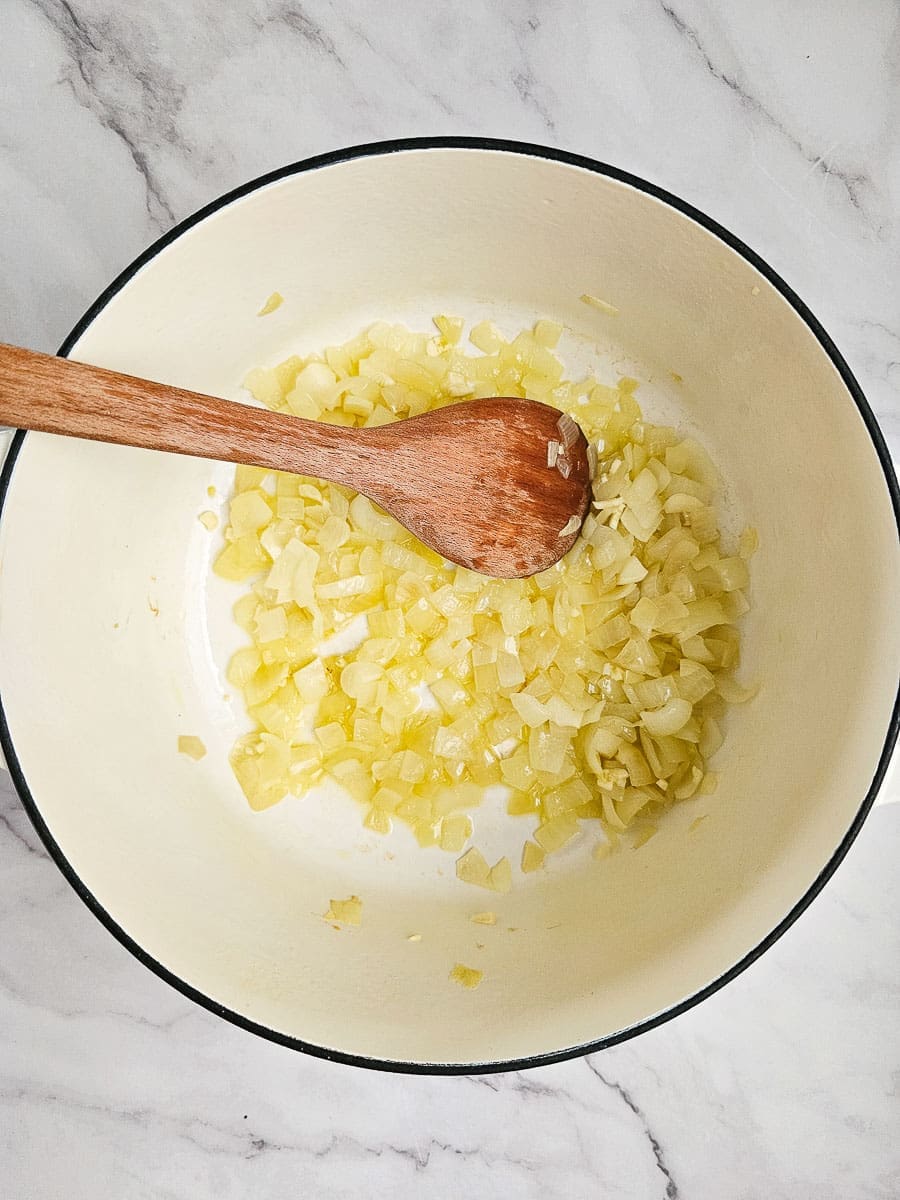
1. Heat oil in saucepan. Add onion and sauté for 2-3 minutes over medium-high heat until the onion is soft. Add the garlic and continue to sauté for 1-2 minutes.
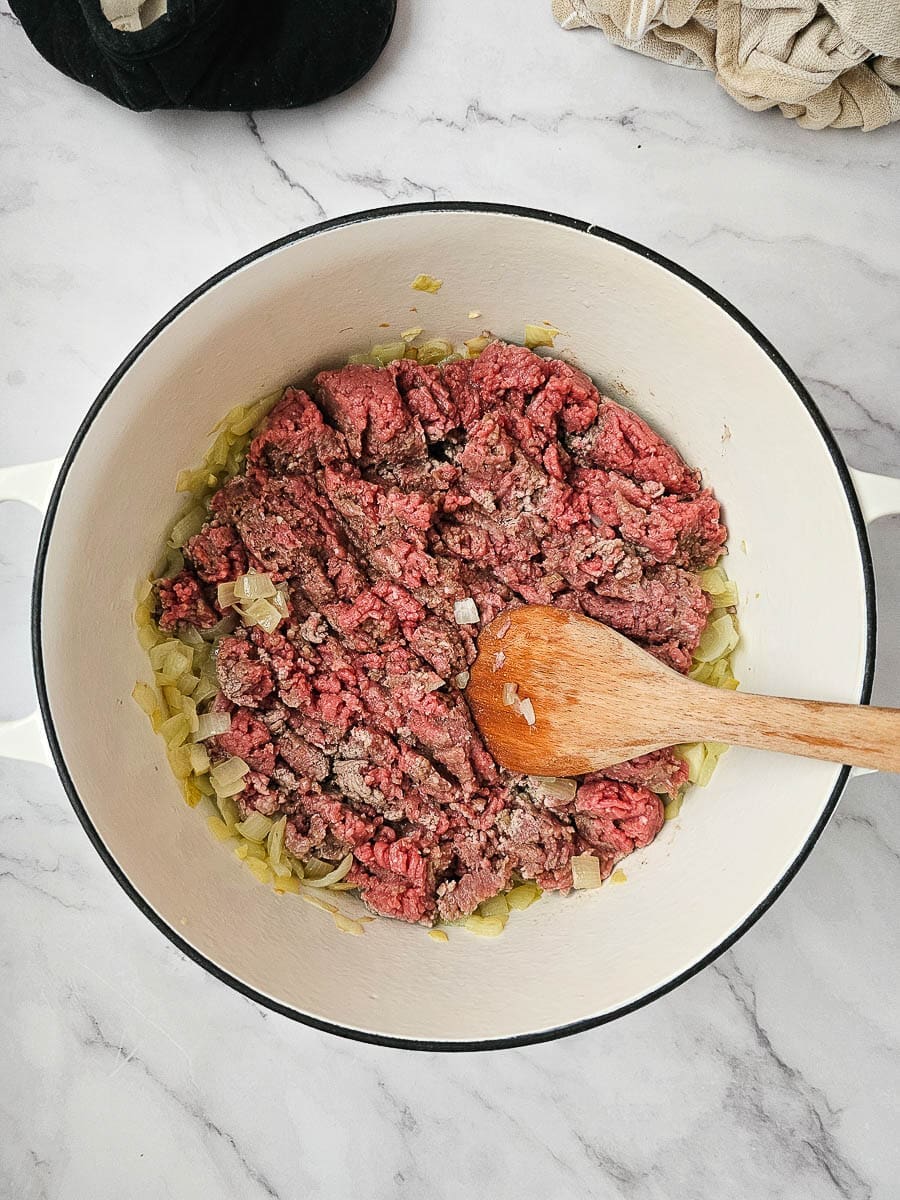
2. Add the beef mince and cook over high heat for 5-6 minutes until browned, using a wooden spoon to break the mince into smaller pieces as it cooks.
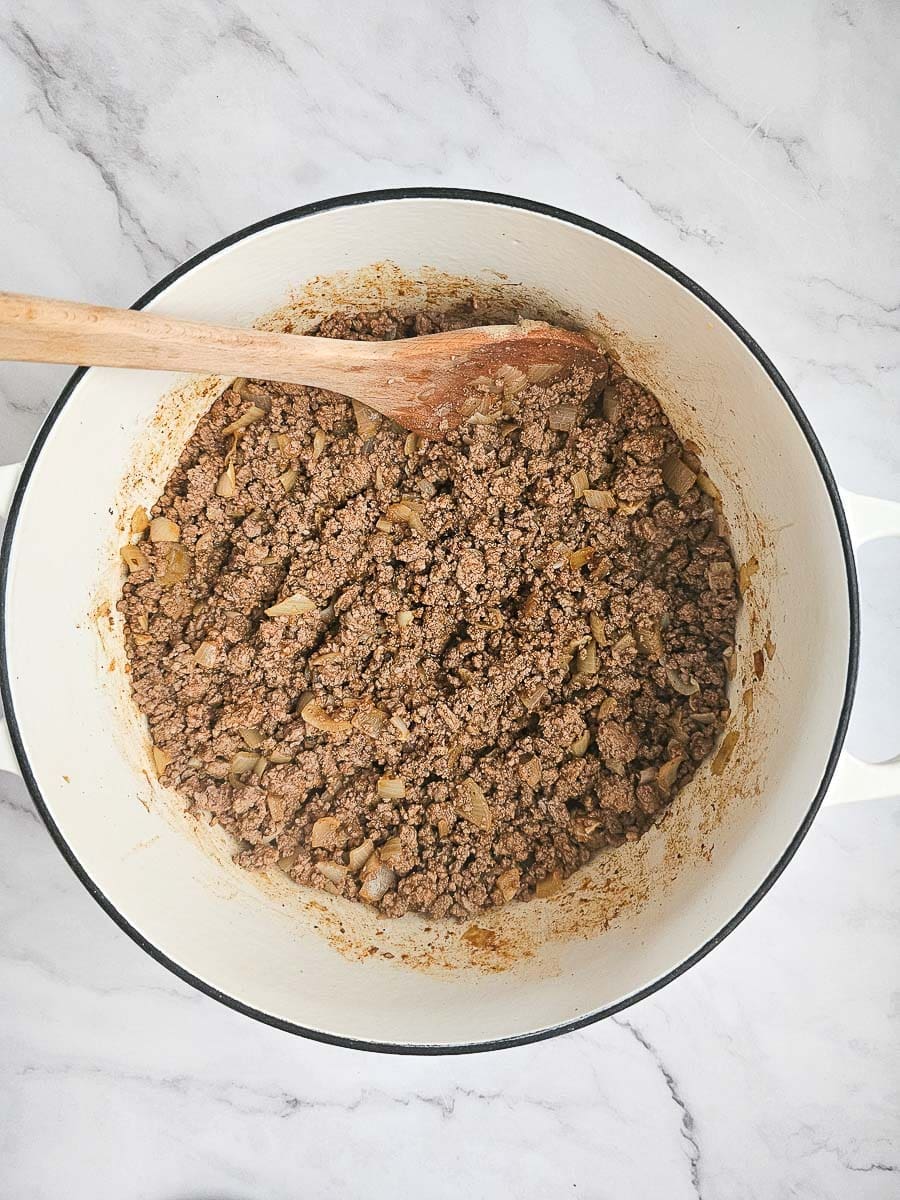
3. Add the tomato paste and cook for 2 minutes. Add cinnamon, pimento berries, oregano, beef stock cube, salt and pepper. Stir for about 1 minute.
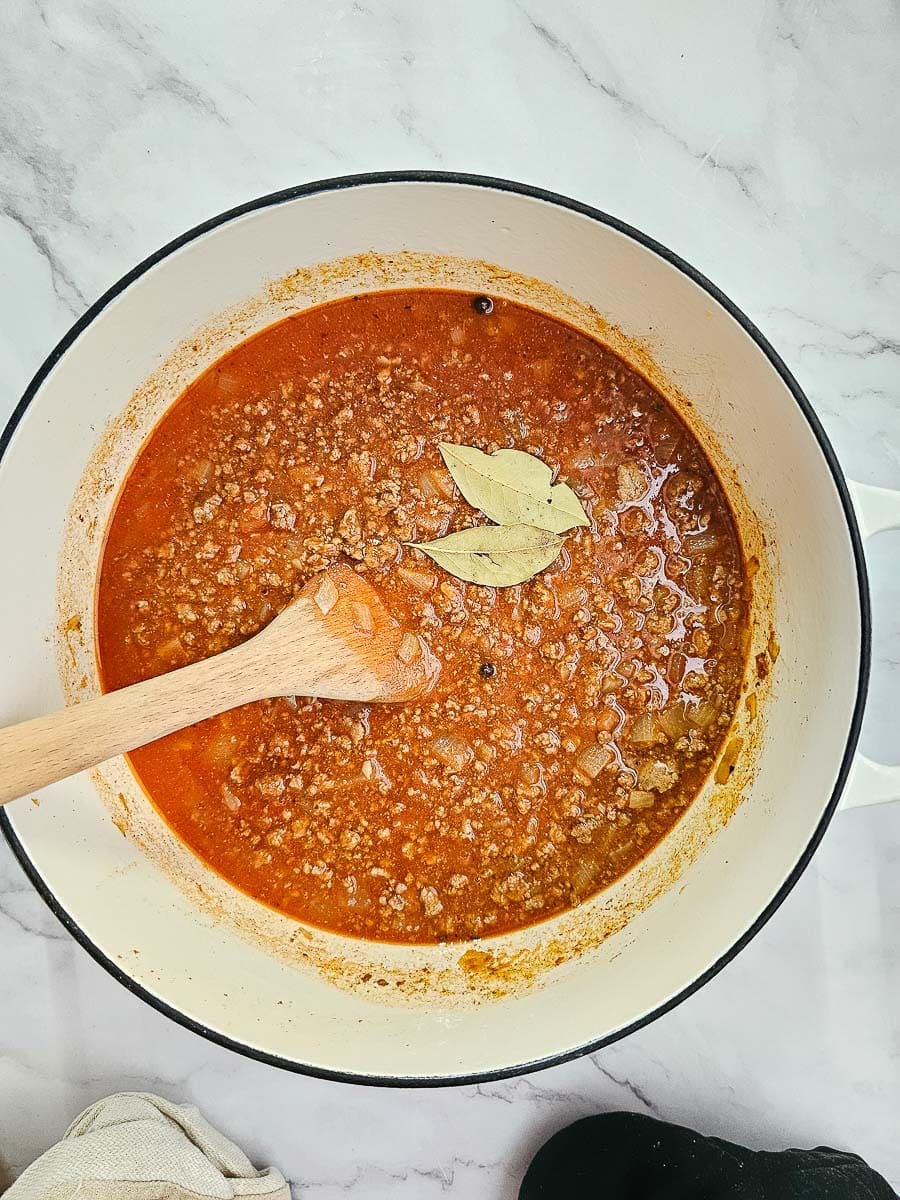
4. Add tomato puree, sugar, bay leaves and water. Bring to boil and then reduce heat to medium-low so it is simmering gently.
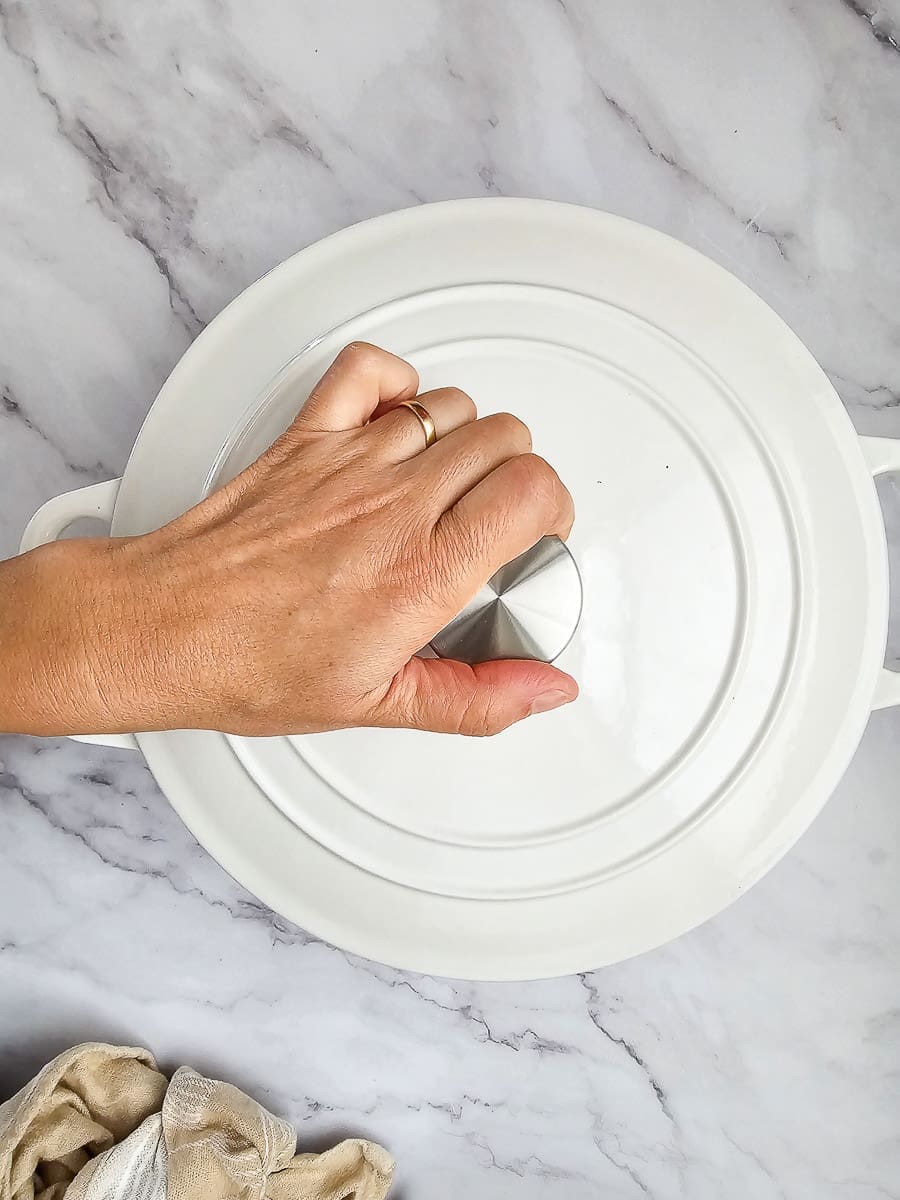
5. Cover and simmer for approximately 35- 40 minutes, stirring occasionally, until most of the water has evaporated.

6. Remove from heat and remove lid. Cool slightly. Remove bay leaves and pimento berries. Mix through the egg yolk.
Ingredients for the pasta layer
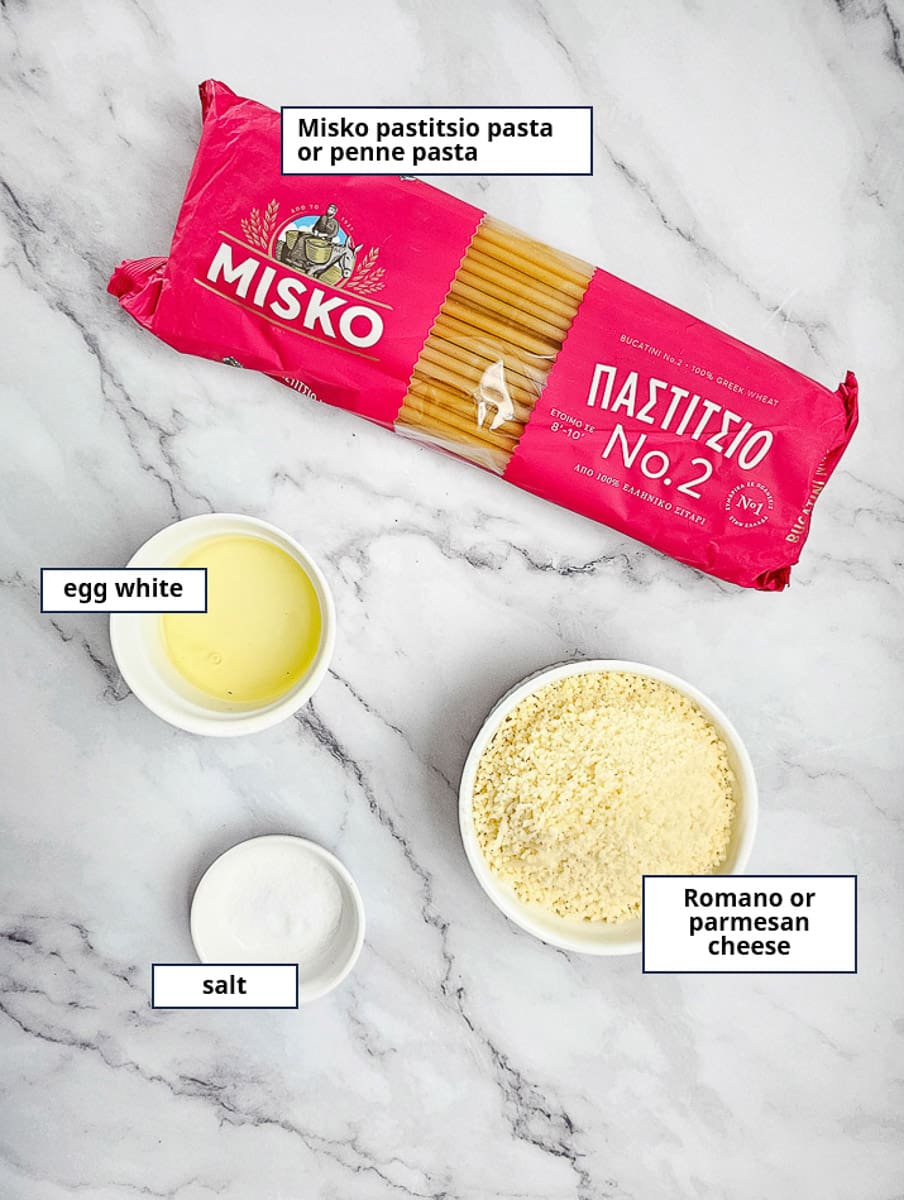
- Pasta: Misko, Pastitsio No.2 is ideal for making pastitsio due to its firm texture that holds up well during baking. You can find Misko pastitsio pasta in well-stocked supermarkets or delicatessens. If unavailable, a suitable substitute could be penne or rigatoni pasta, providing a similar structural foundation for a delicious pastitsio.
- Egg white: Similar to the egg yolk used in the meat sauce, the egg white aids in binding the pasta, to make it easier to slice when it comes time to serve.
How to make the pasta layer for Pastitsio (Greek Pasta Bake)
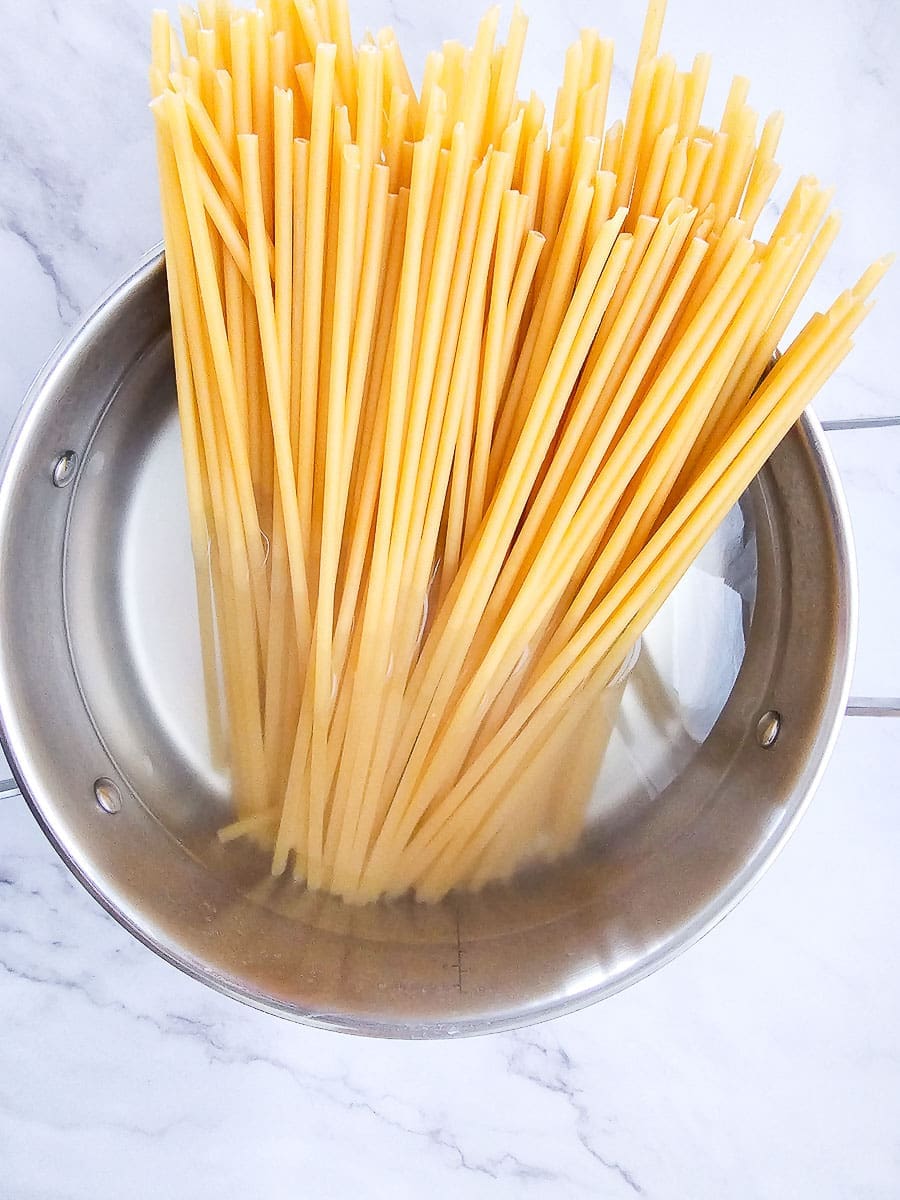
1. Bring a large saucepan of salted water to boil (3/4 filled). Add pasta and boil, uncovered, for 1-2 minutes less than the instructions on the packet.
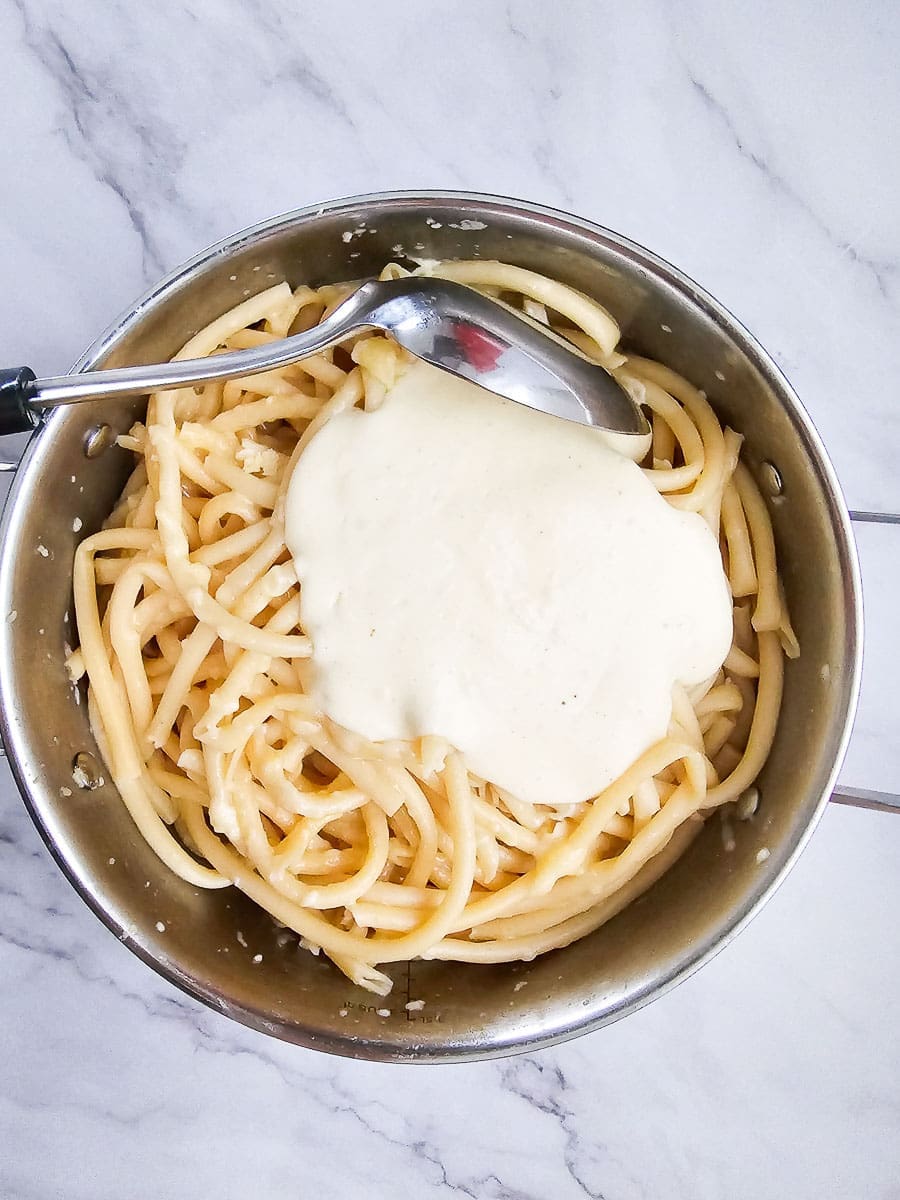
2. Drain. Cool slightly. Mix through egg white, 1 ½ cups cheese and 1 cup bechamel sauce.
Ingredients for the bechamel sauce
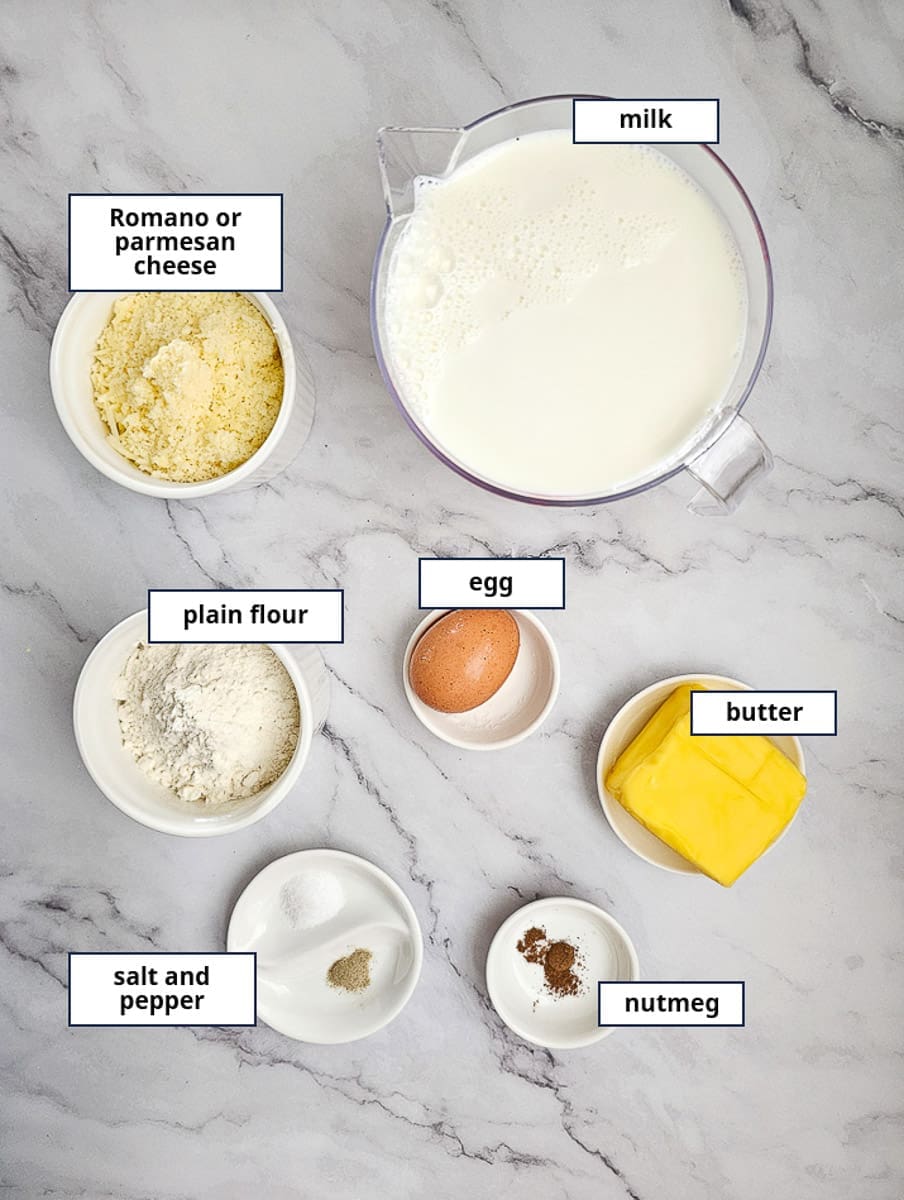
- Milk: I usually use lite white milk as this is what I tend to have in the fridge, but whole milk or plant-based substitutes like oat or soy milk can be used, depending on personal preference.
- Romano or Parmesan cheese: I prefer to use Romano cheese in pastitsio for its sharper flavour and slightly firmer texture, but you can substitute it with Parmesan cheese for a similar depth of flavour with a slightly milder taste.
- Egg: Egg helps to bind the sauce together making it easier to slice into neat portions once cooked.
How to make the bechamel sauce for Pastitsio (Greek Pasta Bake)

1. Warm milk in the microwave for 1 minute.
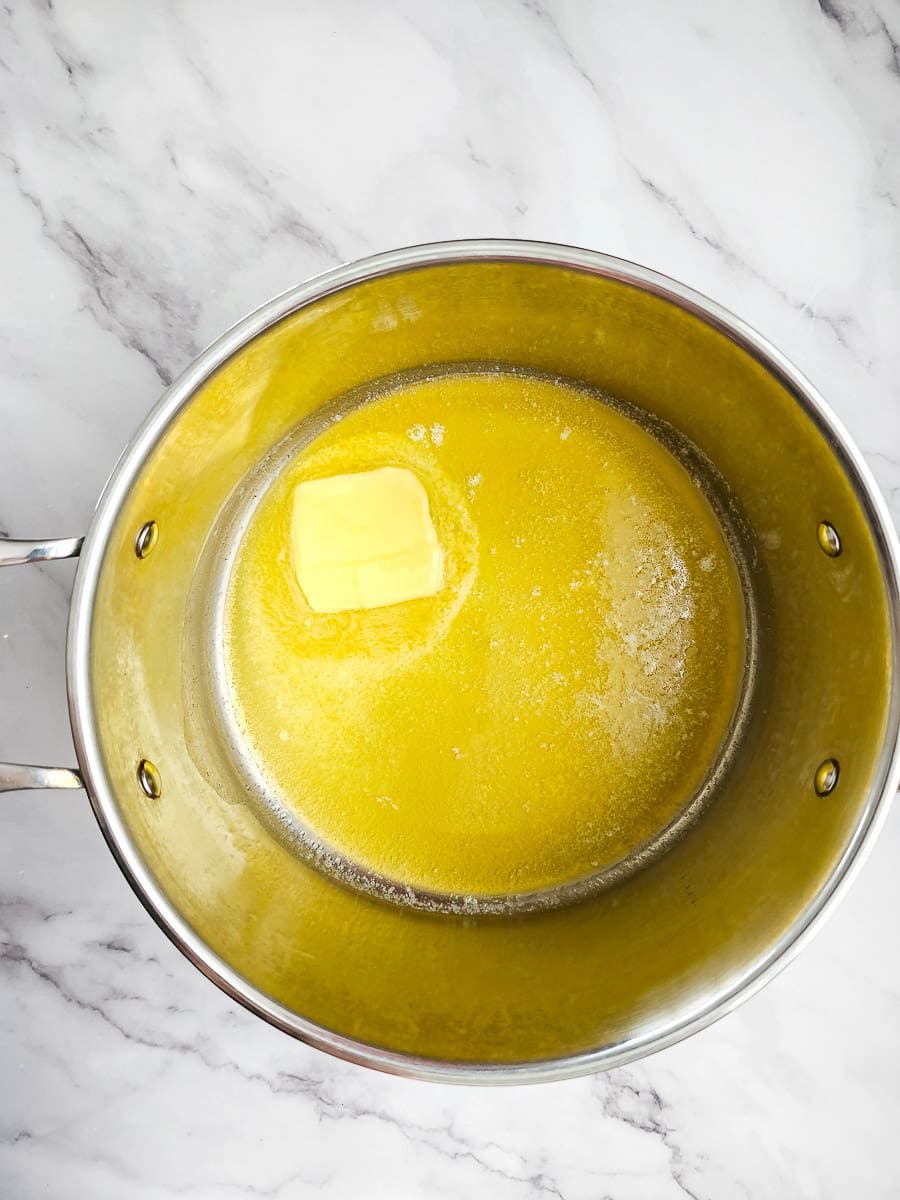
2. Melt the butter in a large saucepan over medium heat.
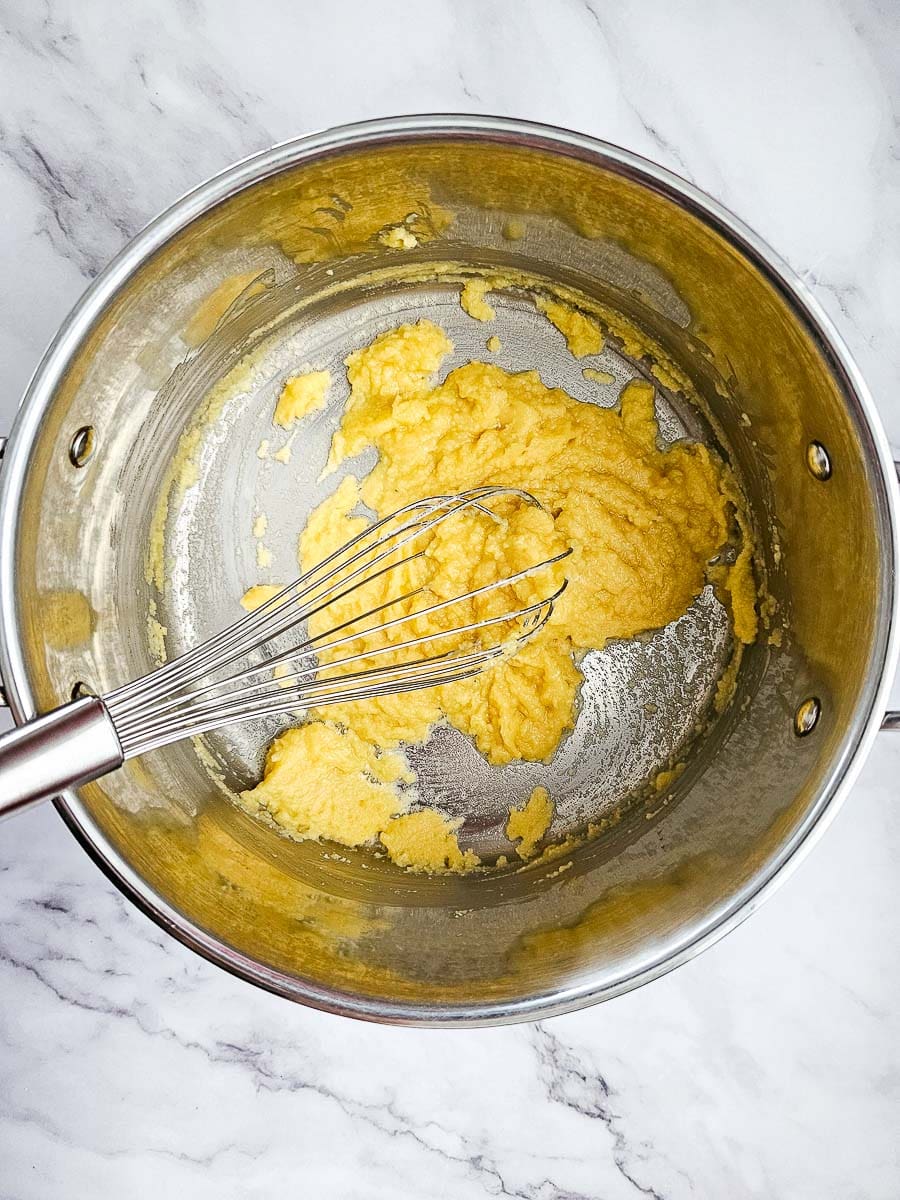
3. As soon as it melts, add the flour, whisking continuously to make a paste (roux). Stir for 1-2 minutes to cook the flour but be careful not to let the roux brown.
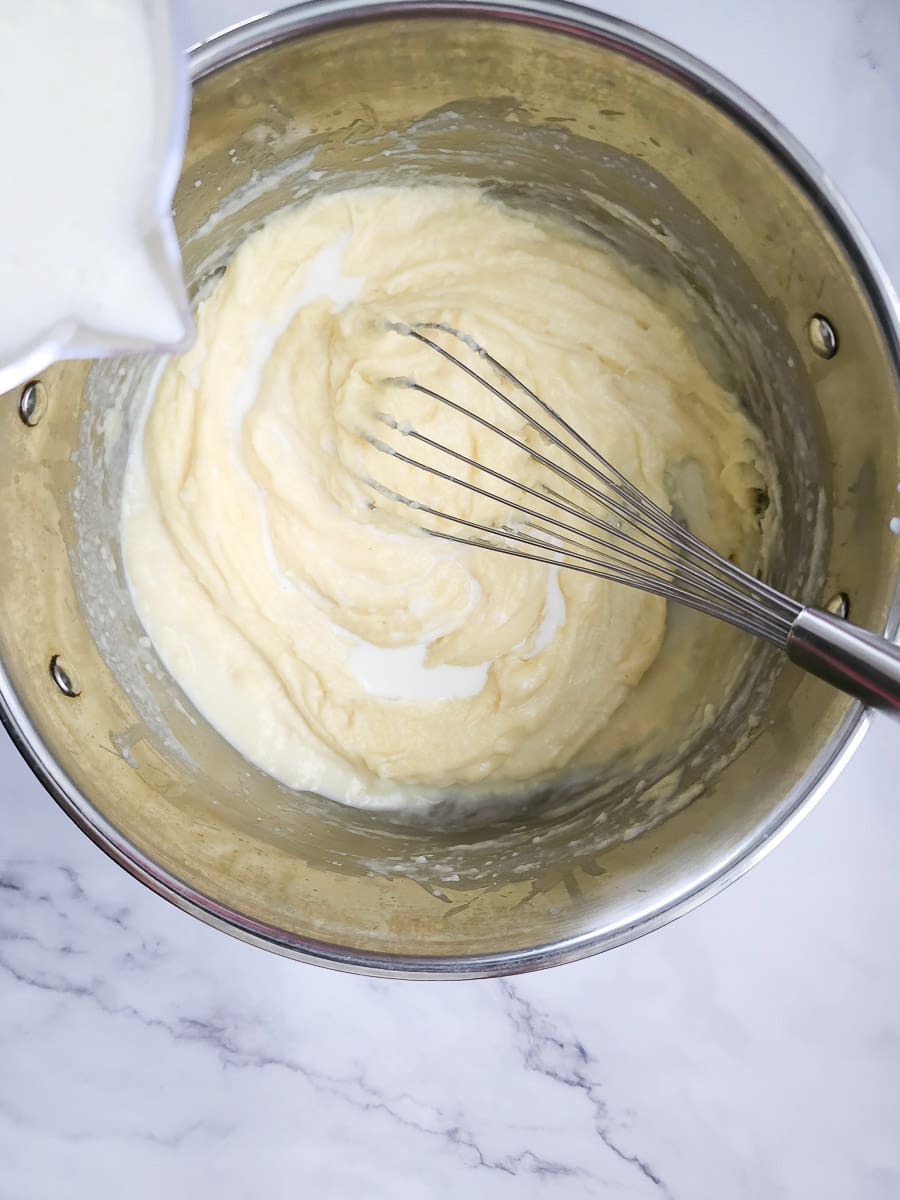
4. Gradually add warm milk, whisking continuously after each addition to prevent your sauce from getting lumpy and sticking to the bottom of the saucepan. The mixture will be quite thick at first, but as you continue to add milk, it will become smooth and creamy.
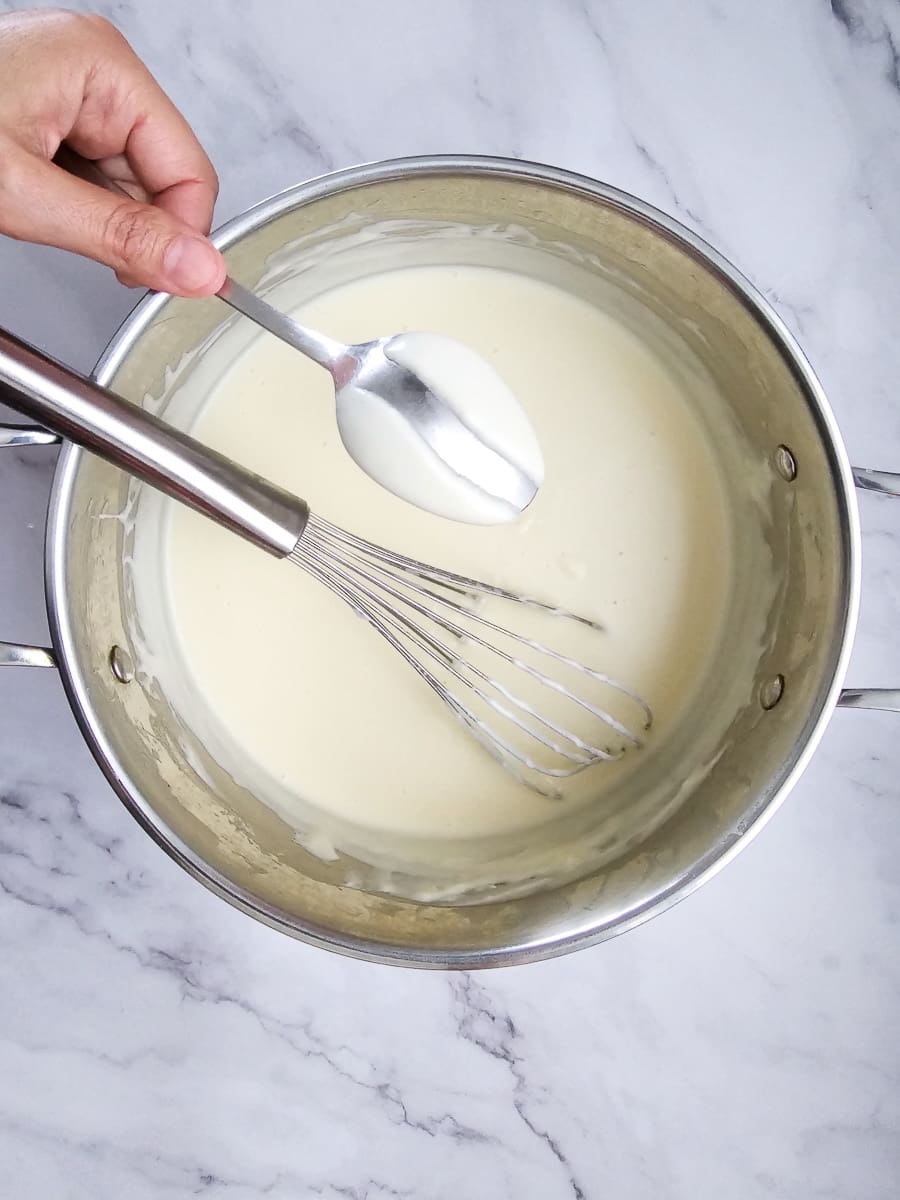
5. Once all the milk has been added, continue whisking over medium heat until the mixture is thick and coats the back of a spoon (about 5-7 minutes).
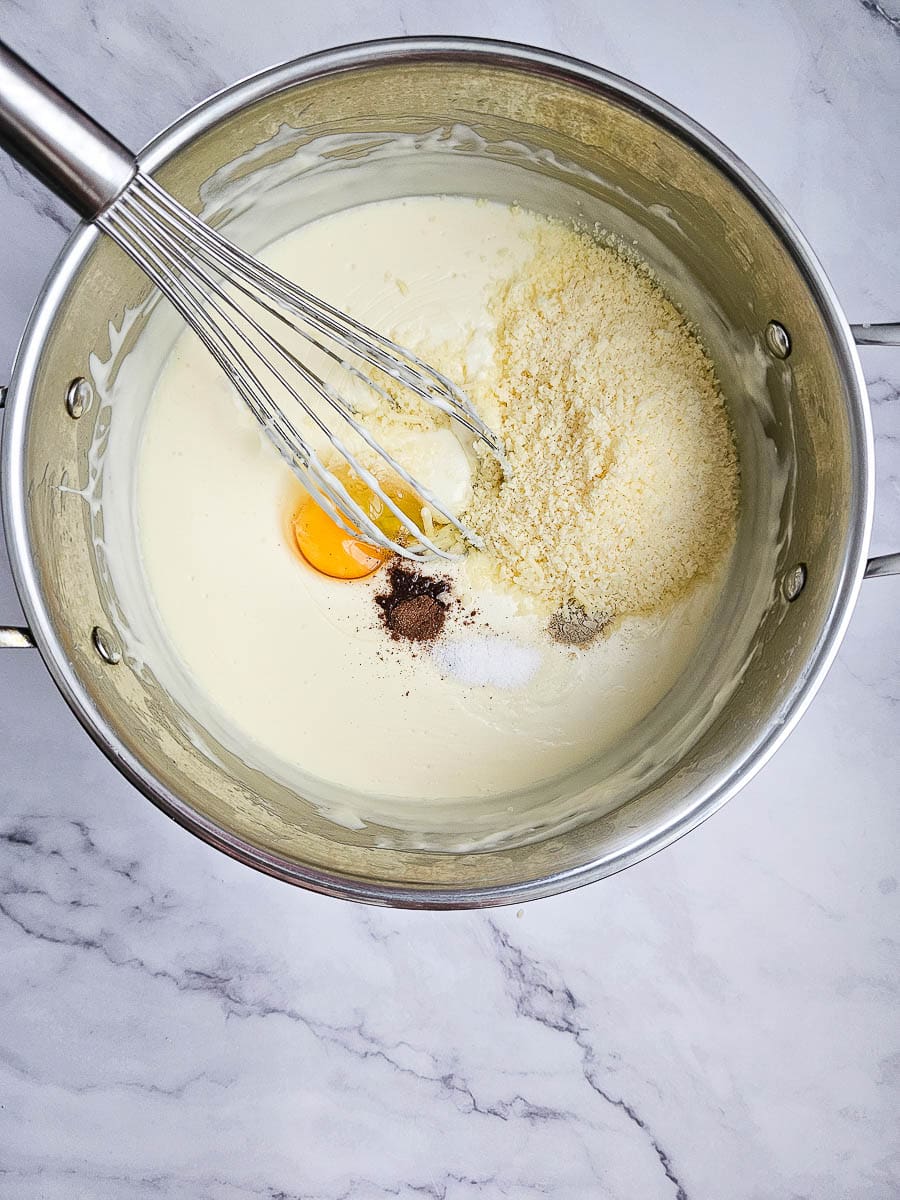
6. When ready, remove from the heat and stir through salt, pepper, nutmeg and cheese. Cool slightly and then whisk through 1 whole egg.
Assemble and bake
When assembling this Pastitsio, there are 5 layers:
- Bottom layer: 2/3 of the pasta.
- Second layer: All the mince.
- Third layer: Rest of the pasta.
- Fourth layer: Bechamel sauce.
- Top layer: Sprinkle with cheese.
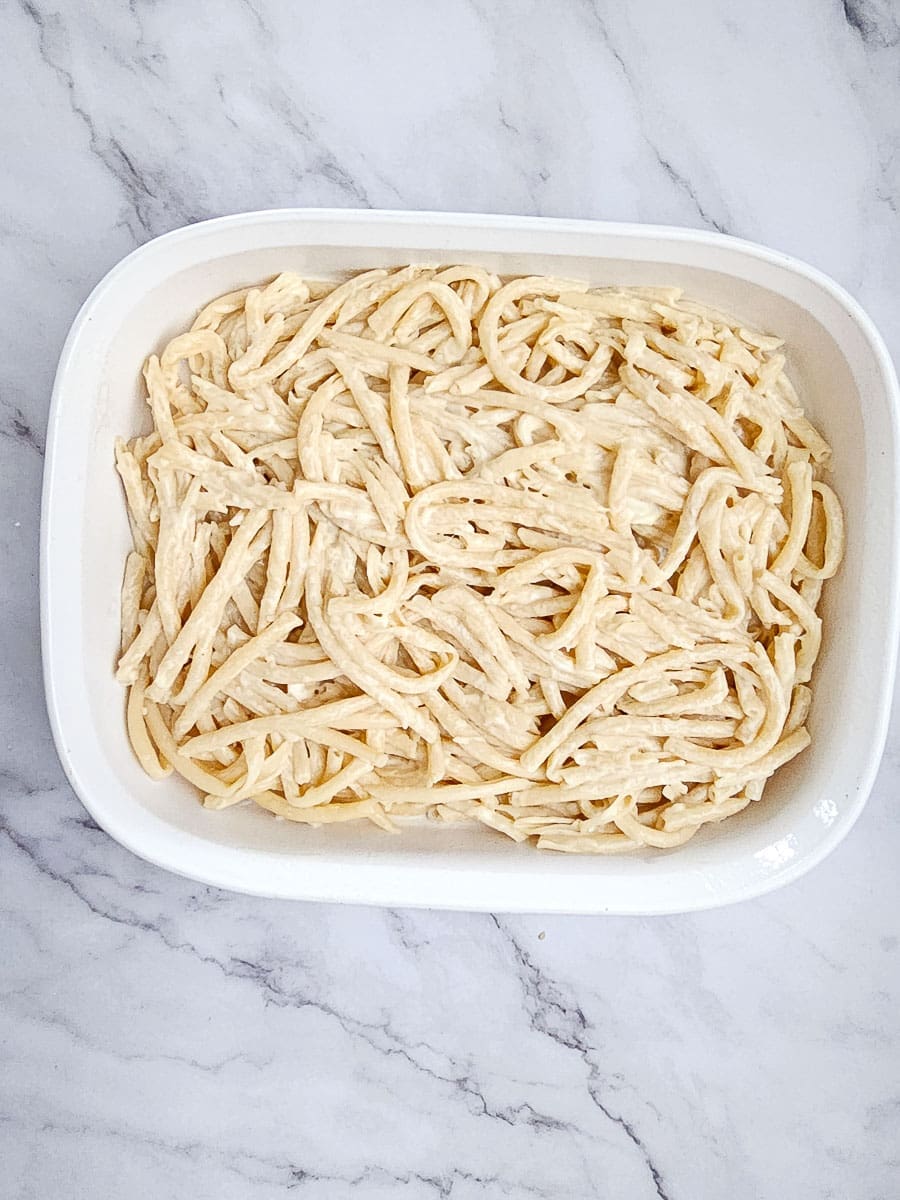
1. Bottom layer: Lightly grease baking dish. Spread 2/3 of the pasta at the bottom of the casserole dish.
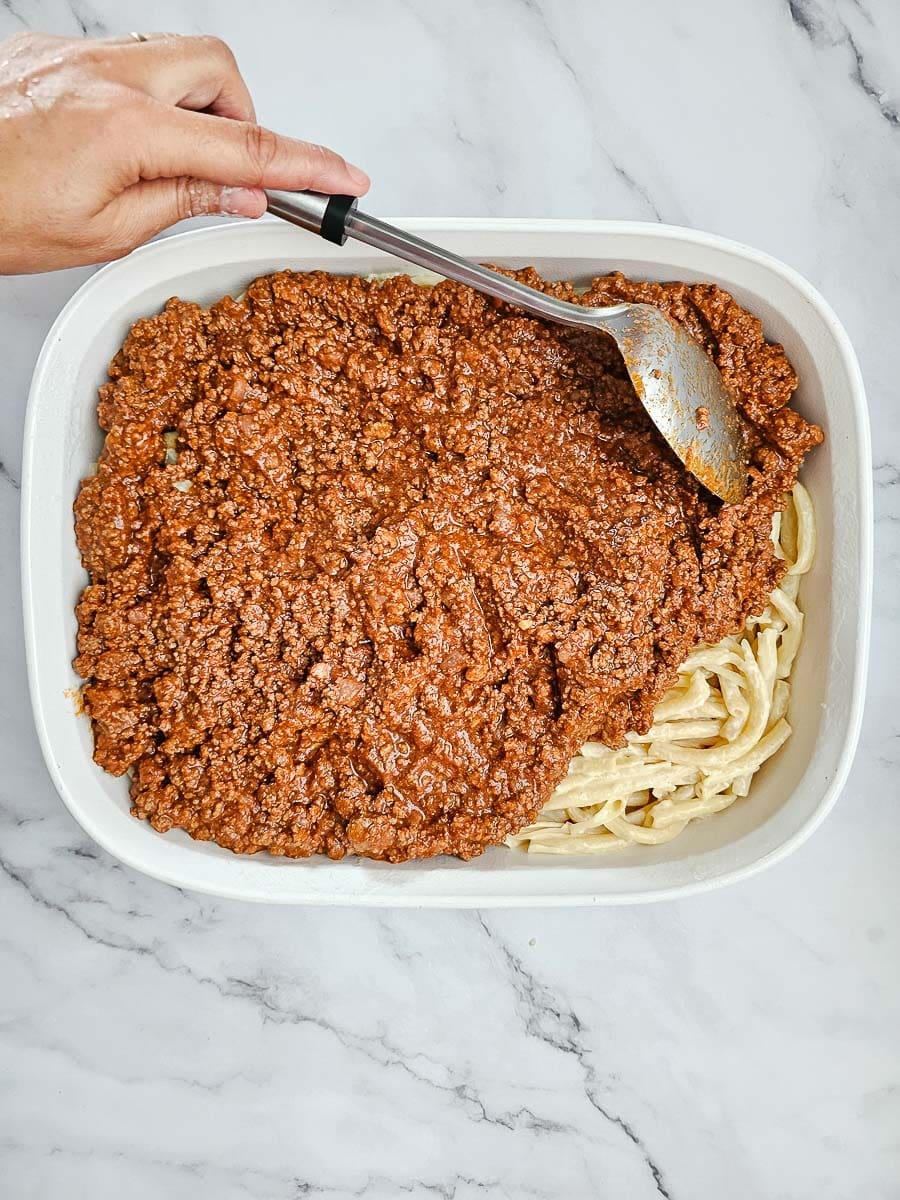
2. Second layer: Spoon meat mixture on top of pasta.

3. Third layer: Spoon the remaining pasta on top.
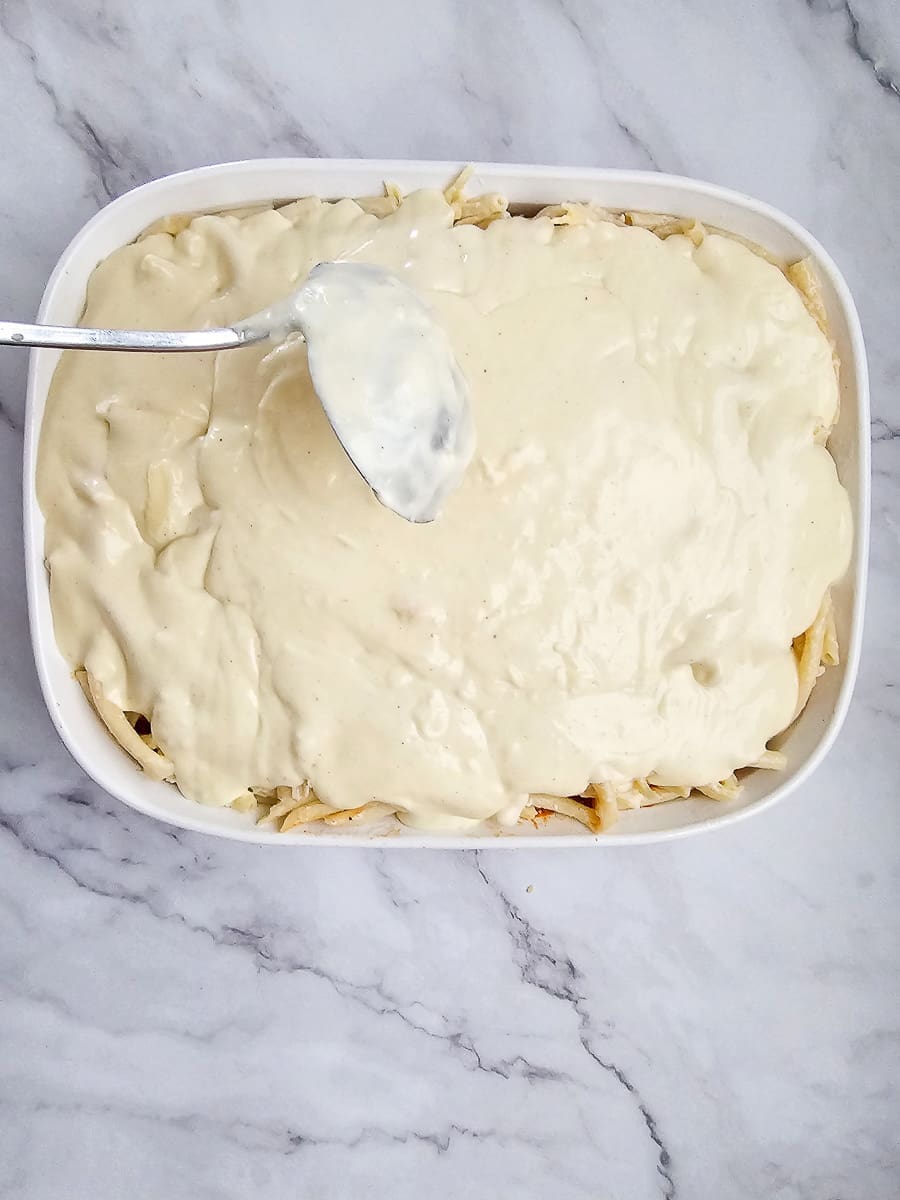
4. Fourth layer: Spread bechamel sauce over pasta.
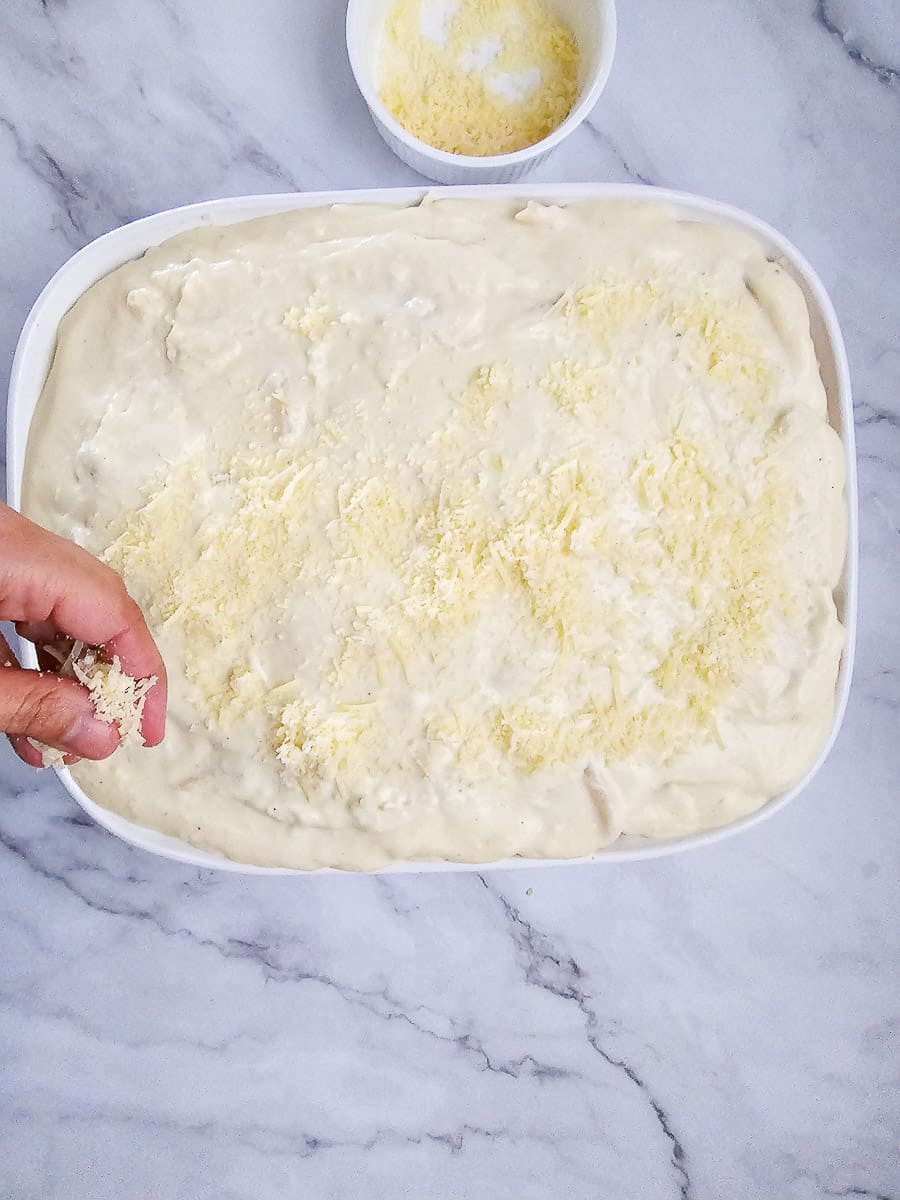
5. Top layer: Sprinkle with cheese. Bake in moderate oven for 40-45 minutes or until golden on top.
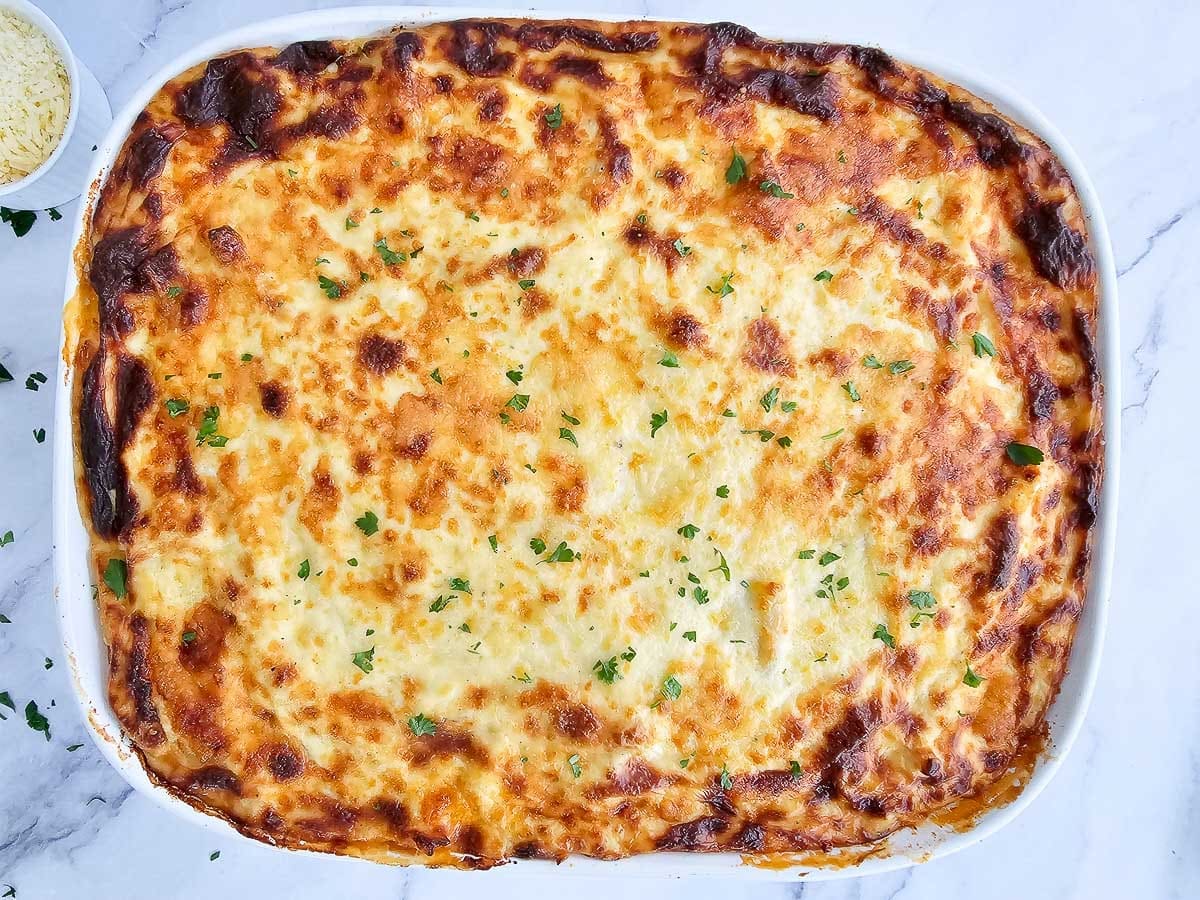
6. Rest for 10 mins so that it is easier to cut the Pastitsio into neat slices.

If you like this dish, check out some of my other main dish recipes:
- Greek Stuffed Tomatoes with Rice (Yemista)
- Greek Lamb and Tomato Stew (Yiouvetsi)
- Vegan Moussaka
- Moussaka (Minced Beef, Eggplant and Potato Bake)
- Soutzoukakia (Greek Meatballs in Tomato Sauce)
Health benefits of Greek Pasta Bake (Pastitsio)
Pasta: Although pasta has been given a bad reputation over the years, it is a central ingredient in the Mediterranean diet. Pasta is a high carbohydrate food that contains glucose, a major fuel for your brain and muscles. Although white pasta is a “refined grain”, which means that the outer coating of the wheat kernel has been stripped of some of its components, it still contains a good source of fibre and is enriched with B vitamins and iron.
Lean beef mince: In the traditional Mediterranean diet, red meat is consumed in moderation, typically no more than a few times per month. Lean beef mince contains important nutrients such as protein, which is crucial for building and repairing tissues and supporting muscle growth. It is a good source of iron, which aids in oxygen transport and energy production, as well as zinc, which supports immune function and promotes wound healing.
Milk: Milk provides important nutritional benefits through its rich content of protein, calcium and vitamin D. Protein in milk supports muscle growth and repair, while calcium is essential for strong bones and teeth. Vitamin D helps the body absorb calcium, promoting bone health and supporting overall immune function.
Tomato: Tomatoes contain vitamin C, for immune system function, and potassium, for blood pressure control. It also contains the antioxidant lycopene, which has been linked to many health benefits including reduced risk of heart disease and cancer, and a reduction in inflammation throughout the body.
Romano/Parmesan cheese: This cheese is rich in protein, providing essential amino acids necessary for tissue repair and muscle development. It is also a good source of calcium, which supports bone health.
Tips for making Pastitsio (Greek Pasta Bake)
Sautéing the spices and herbs first
Sautéing cinnamon, berries, oregano and bay leaves in the oil before adding the tomato puree and water allows their flavours to develop fully, enhancing the overall aroma and taste of the dish while ensuring even distribution.
Partially prepare ahead of time
To prepare Pastitsio ahead of time, cook the pasta and meat sauce the day before. On the day of baking, make the béchamel sauce, assemble the Pastitisio and bake. Alternatively, you can prepare the whole dish in advance and simply bake it on the day you plan to serve it. Just refrigerate the assembled Pastitsio, then pop it in the oven when you’re ready to bake and enjoy. If you are using a ceramic or glass baking dish, ensure that you have allowed enough time for the baking dish to cool down before baking, as these materials can crack if exposed to rapid temperature changes. To prevent this, I place the baking dish in the oven while the oven preheats. Another option is to use a metal baking dish, which is less likely to crack due to temperature changes.
Leftovers
This recipe yields sufficient portions for two dinners, accommodating a family of four. If you enjoy having leftovers, this means you can take a break from cooking for one evening.
Storage
Pastitsio keeps in the fridge for 4-5 days or freezes for up to 3 months. When ready to reheat, thaw in fridge overnight and then warm the Pastitsio in a moderate oven or in the microwave until heated through.

